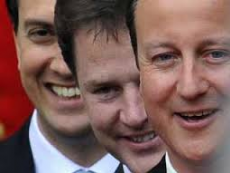
Email: ZYVC057@live.rhul.ac.uk
Total Article : 213
About Me:I'm a graduate student studying International Criminal Law and first started writing for King's News almost 4 years ago! My hobbies include reading, travelling and charity work. I cover many categories but my favourite articles to write are about mysteries of the ancient world, interesting places to visit, the Italian language and animals!

As the UK general elections are swiftly approaching, party leaders have been trying to rally up more support through charismatic speeches and hopeful promises of change. Lately, the media has focused more on a leader than their own party! The academic world responded by posing an increased importance on the study of party leaders which has become an essential factor that can determine who we will vote for in the next elections.
In 1964 Philip Converse noted that the general public was simply not as interested in politics as political scientists would have expected them to be. We idealised citizens’ level of interest when it came to politics and it did not correspond to reality. Ideally, a voter would closely look at all the policies of each party and, based on that, make a rational decision of who to vote for. In a fast-paced world where google can summarise almost anything this is not the case. Instead, it seems that people are much more inclined to use short cuts, such as general impressions they perceive from each party. These images voters have of parties are influenced strongly by marketing and the media, party identification (a person is more inclined to respond favourably to a party they are already identify themselves with) and the leader of the party. Parties are not only branding themselves now but they brand their leader, whose role is almost more important than that of the party itself.
The limited effect theory explains that what we think of a party leader is strongly influenced by partisan sympathies, that is how much we like the party. According to this theory, when we are fond of a party but we do not agree with the party leader we would still choose the party. Having said this, electoral analysts have been observing the growing division between parties and their leaders. All mainstream media channels such as the radio and television have now placed political leaders in the spotlight.
Party leaders help simplify the voting procedure for citizens and some believe people are more likely to vote for an individual leader than for their party. This also puts more pressure on party leaders to act and present themselves in a pleasurable way. More and more emphasis has been drawn not only on the tone in which leaders deliver their speeches but also on the way they walk, the clothes they wear and the entire ‘look’ which citizens can relate too. UKIP leader Nigel Farage has gained more support than any former UKIP leader and many pin this down to the fact that he is approachable. He depicts himself as one of the boys, a friendly man who is outraged with the current British political system and demands for change. Once people buy into this lad nature – which is quite far from his ‘posh Eton’ friends including David Cameron - it becomes easier to accept the radical ideas UKIP is putting forward. Italian politician Silvio Berlusconi is another example of how politicians now need to have the ‘look’ as he bought hair implants to keep a younger image. French politician Nicolas Sarkozy stands on an elevated platform when making speeches to make him appear taller than he is and ultimately more authoritative. When assessing the impact leader images have on voting, scholars have come to very different conclusions. How important do you think leader image is in elections? Do you think a party could survive without a charismatic leader?
Image: http://junonews.org/wp-content/uploads/2014/01/Leaders2.jpej

0 Comment:
Be the first one to comment on this article.